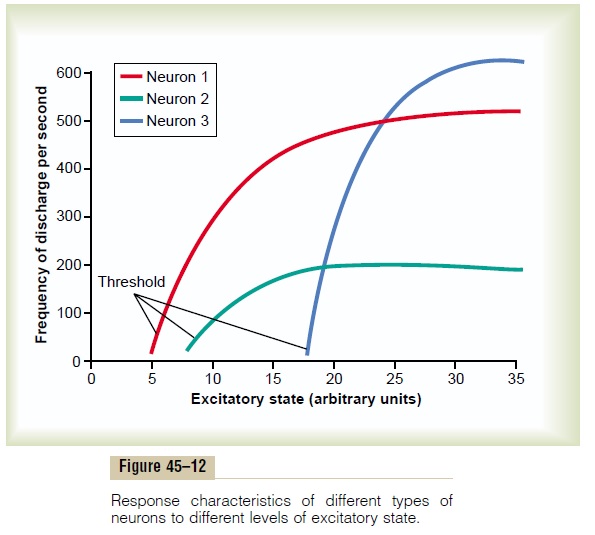Chapter: Medical Physiology: Organization of the Nervous System, Basic Functions of Synapses, “Transmitter Substances”
Relation of State of Excitation of the Neuron to Rate of Firing - Central Nervous System Synapses
Relation of State of Excitation of the Neuron to Rate of Firing
“Excitatory State.” The“excitatory state”of a neuron isdefined as the summated degree of excitatory drive to the neuron. If there is a higher degree of excitation than inhibition of the neuron at any given instant, then it is said that there is an excitatory state. Conversely, if there is more inhibition than excitation, then it is said that there is an inhibitory state.
When the excitatory state of a neuron rises above the threshold for excitation, the neuron will fire repet-itively as long as the excitatory state remains at that level. Figure 45–12 shows responses of three types of neurons to varying levels of excitatory state. Note that neuron 1 has a low threshold for excitation, whereas neuron 3 has a high threshold. But note also that neuron 2 has the lowest maximum frequency of dis-charge, whereas neuron 3 has the highest maximum frequency.

Some neurons in the central nervous system fire continuously because even the normal excitatory state is above the threshold level. Their frequency of firing can usually be increased still more by further increasing their excitatory state. The frequency can be decreased, or firing can even be stopped, by superim-posing an inhibitory state on the neuron. Thus, dif-ferent neurons respond differently, have different thresholds for excitation, and have widely differing maximum frequencies of discharge. With a little imag-ination, one can readily understand the importance of having different neurons with these many types of response characteristics to perform the widely varying functions of the nervous system.
Related Topics